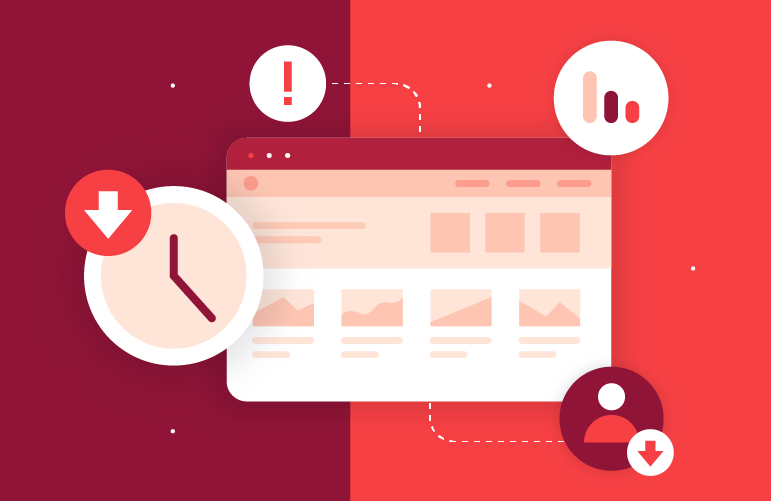Downtime is never a good thing for websites. It means that your site is unavailable, won’t load properly, or that it is loading, but so slowly that visitors lose patience and leave. By the way, it doesn’t take long for anyone to lose patience; in 2019, Unbounce reported that users will leave if a site if it doesn’t load within 3 seconds, and I think we can all agree that we haven’t become any more patient since then.
We’ve all been there, wondering if the content we need is ever going to appear (that’s why there are sites like DownForEveryoneOrJustMe), but unfortunately, a lot of us have also been on the other end of the experience, trying to cut downtime for our own sites. So let’s talk today about website downtime, why it’s so harmful to your business, and what you can do to prevent it.
What causes website downtime?
Like most things in the world of websites, there’s no single answer. There are a number of reasons why websites might go down, and sometimes it can be a combination of factors that brings down a site.
Shared hosting
One of the most common reasons for unplanned website downtime is due to shared hosting: website hosts crowd many sites onto a single server, and the server often can’t cope with your combined activity. It can happen even if the server is only hosting a few sites, because if one site has a big traffic spike, it can take everyone down. Your site can also be affected by malware attacking another site on the server your site is sharing with others.
Malware or hacking attempts
If your site has fallen prey to malware or a hacker attack, there could be a malicious actor somewhere siphoning off resources to slow down your site, hackers could even take your entire site down, or make coding changes to the back end that cause your site to stop working.
Update conflicts
As you already know, WordPress themes, plugins, and WordPress itself need to be updated as patches become available. Although developers do their best, it can be hard to keep on top of the constant updates being released. And once you have applied the updates, sometimes a bug can slip in, or an incompatibility materializes between the update and something else on your site. It can happen that simply by updating your site, you end up breaking something else which results in your site becoming unavailable.
Too popular
In some ways, this is the “best” reason for website downtime: your marketing campaign was so amazing that it went viral and generated a shock spike in traffic to your site. It’s awesome to be popular, but it’s frustrating that after so much energy, planning, and budget, success killed your site.
Why does it matter if your website is down?
You might wonder if it’s such a big deal if your website experiences downtime. After all, website downtime can happen to everyone, even giants like Google and Facebook. Stuff happens.
Well, website downtime is a big deal, and here’s why.
You lose money
If you’re running an ecommerce site, then website downtime is like suddenly closing your store in the middle of a busy shopping day, because suddenly no one will be able to buy anything from you. But even non-ecommerce sites generate revenue for businesses by acquiring new prospects, nurturing leads with content, supporting online demos, and even simply raising brand awareness. When these types of sites are down, they are also losing potential business.
When Google was down for 5 minutes, it cost the company half a million dollars in ad revenue. Even though your company isn’t on Google’s scale, you’ll still accrue losses without a working website. Gartner says that on average, companies lose about $5,600 for every minute their site is down, while Carbonite calculates that small companies lose out on an average of $137-427 during each minute of downtime. These estimations are several years old, and the costs have only increased since then.
Your SEO will take a hit
You’ve worked hard to improve your search engine ranking, and have invested time and effort into optimizing your content and building high-quality backlinks. But page load speed and site downtime can ruin all that hard work. If your website is offline for one day, research has shown that you’ll see search rankings wobble for about 1-3 weeks before returning to normal. That’s because the Googlebot is recrawling your site and judging how stable it is. If your site is often down, Googlebot crawls it less frequently, and eventually, your site could be permanently de-indexed.
Core Web Vitals are a major part of Google’s algorithm for organic search rankings, and while the main focus is on factors like site speed and other user experience metrics, having your site go down is not going to help your Core Web Vital score.
Your brand reputation will suffer
You can’t put a price on brand credibility. All your marketing efforts and budget lead up to building a brand reputation, but when your website is down, your brand reputation comes crashing down with it.
Website downtime makes you look unprofessional and unreliable, and that affects your offline reputation as well as your online one. You’d much rather have social media mentions praising your great customer service, rather than complaining about how your website is unavailable.
Your customers will lose trust
Brand reputation and customer trust are intimately connected. If you can’t keep your website up consistently and have it load swiftly, your customers will wonder if they can trust you to be a professional supplier, or keep their personal information confidential and their credit card details safe from hackers. According to Akamai, 9% of visitors who encounter a down website will leave and never return.
You’ll lose sleep
You just know that if your site goes down, it will happen at the least convenient moment, like over the weekend when you’ve logged off to enjoy some family time, or when your web developer has traveled to a distant island and can’t be reached.
You won’t relax until the site is back up again, even if the technical issues aren’t your personal responsibility, and then you’ll continue to worry that it will happen again for months after the event. Can you handle the stress and the lost sleep?
How to prevent website downtime
Now that we’ve convinced you that website downtime is a terrible, no-good, very bad thing, let’s talk about what you can do to prevent it. Here are 6 tactics to reduce the risk that a downed website could happen to you.
1. Use a reliable hosting company
Check and double-check that your hosting company has a reputation for high uptime. Examine their uptime SLA. 99% uptime might sound impressive, but it means your site could be down 3.65 days a year, or 1.68 hours a week.
2. Monitor your site
Sporadic monitoring isn’t enough; you need to track site performance around the clock. Tools like Pingdom and Uptrends can help you spot the first signs of downtime so you can step in faster to resolve issues and get your website back up sooner.
3. Use a CDN
Aside from speeding up your page load times, a CDN helps improve availability and redundancy for your website which reduces the risk of downtime. With a CDN, even if one edge location goes down, the other ones will cover for it.
4. Maintain site security
Since hackers and malware are a common cause of site downtime, it’s important to do all you can to keep them out. Always update security plugins, and use a Web Application Firewall or other perimeter defense tool to further protect your site.
5. Test updates
As we already mentioned, plugin and theme updates are another frequent culprit of website downtime. To avoid having an update break your site, test the update on a development site before you go live with it on your production site.
6. Always have a backup
In addition to doing all you can to prevent your website from going down, you should also prepare for the worst-case scenario and have a backup site ready to roll. Test it in advance to make sure that the backup is easy to restore and reliable.
It would be hard to over-emphasize the importance of preventing downtime. Every minute your website is unavailable potentially produces both customer and financial losses. As a best practice, work only with reliable hosting providers with solid track records in mitigating downtime from hacking attacks or outages. And finally, make sure you have a reliable uptime monitor set up so you can respond as fast as possible if you do end up with a site that has gone down.




